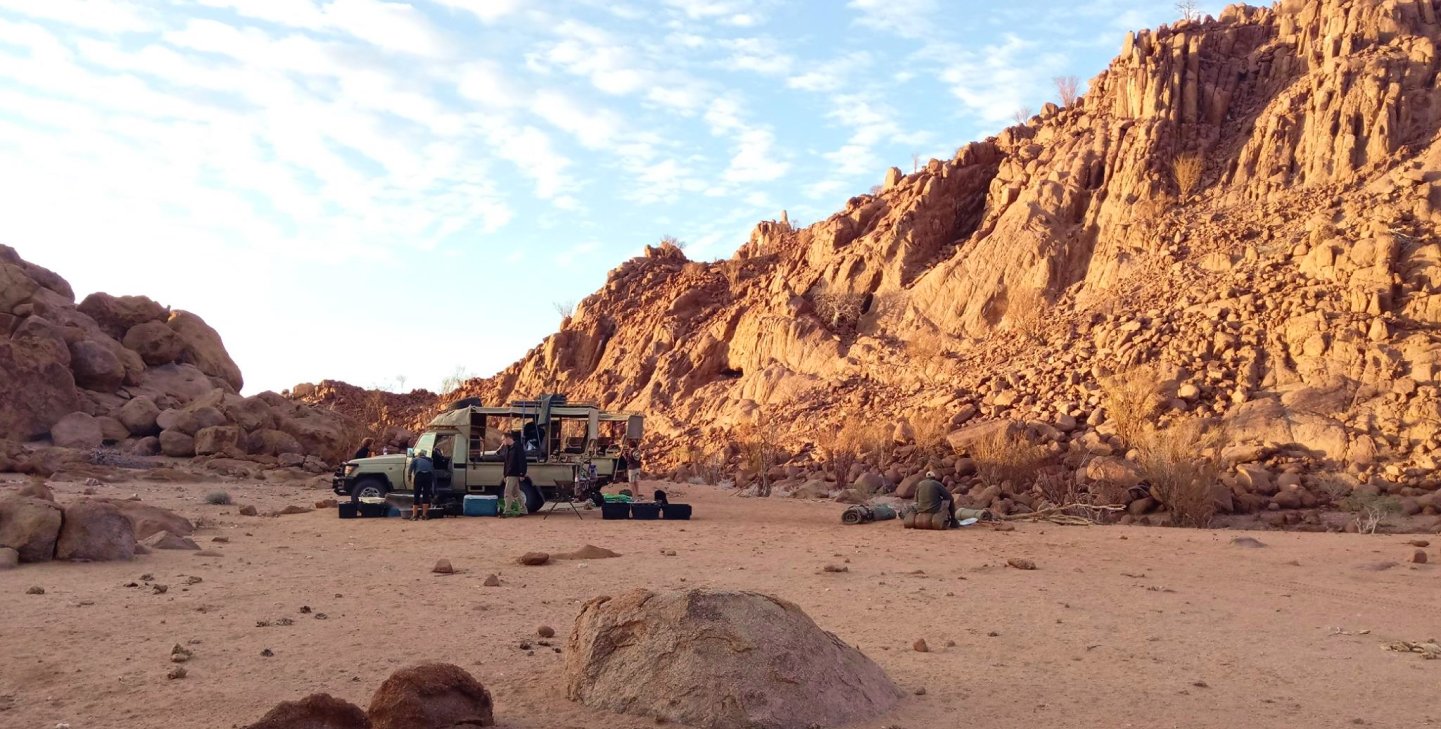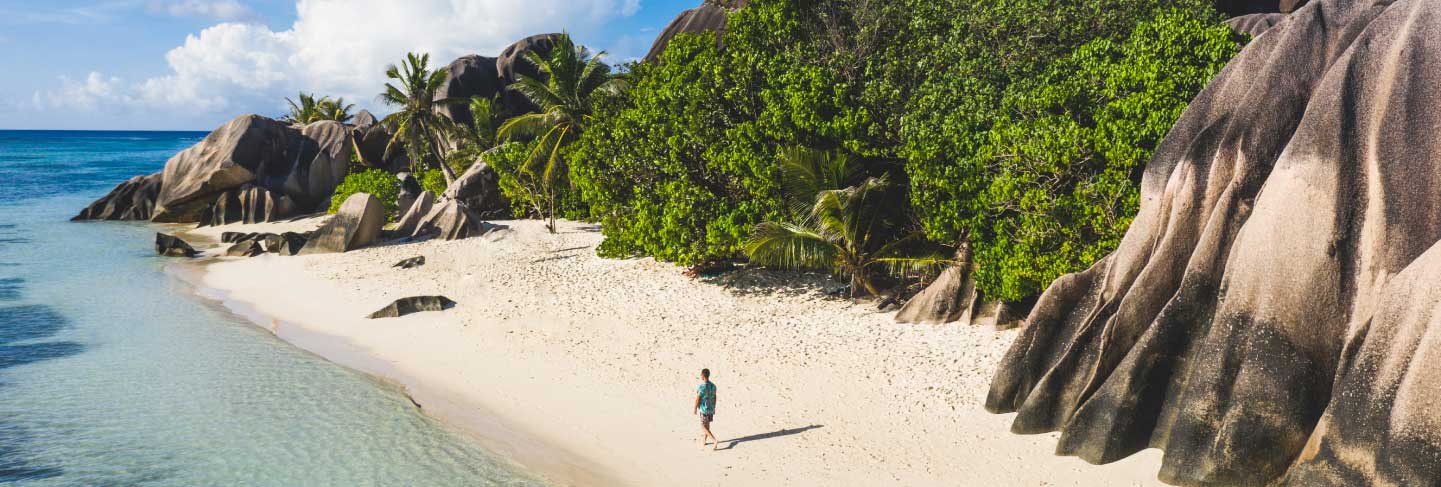Volunteer in Namibia
Join efforts to protect Namibia’s desert-dwelling elephants.
Travel to Namibia’s true wilderness, the desert landscapes of Damaraland, where you’ll join conservation efforts to protect local populations of desert-dwelling elephants. As a volunteer in Namibia, you’ll help build barriers around critical water sources for local communities, track and monitor elephants, camp in the wild and contribute directly to conservation efforts. Experience desert living and look out for African wildlife including black rhino, cheetah, lion, oryx and brown hyena.
Head to Namibia’s remote wilderness in the desert landscapes of Damaraland, near Skeleton Coast National Park. Join our field team as you monitor desert elephant movement, identify individuals, study behaviour and contribute to a growing database for conservation efforts. As a wildlife volunteer, you’ll assist with critical infrastructure projects to protect local water resources and reduce elephant-human conflict.
Project work occurs in the Namib Desert, a vast and true wilderness. African wildlife that call this landscape home have developed unique adaptations for survival. Species to look out for include desert-dwelling elephants, lions, giraffes, black rhino, oryx, brown and spotted hyena.
When you volunteer in Namibia with GVI, you’re heading to a remote and beautiful desert landscape. Our programs provide the chance to disconnect from the busy world and contribute directly to desert elephant conservation.
Filter programs
Contribute to sustainable conservation projects led by experts.
Use your unique skills and expertise to support conservation projects.
The adventure of a lifetime while making an impact with a group of like-minded teens.
Generate solutions to help solve conservation challenges through research projects.
Turn your passion into your profession with a three-month placement at an NGO.
Begin your journey in Swakopmund, a town uniquely positioned between Namibia’s west coast and the vast Namib Desert. Consider planning a bit of extra time in Swakopmund, Windhoek or other destinations in Namibia before or after your volunteer program. Activities in the area include quad biking, paragliding, sand dune surfing, safaris, desert day trips and more. Many participants also take the opportunity to learn how to surf.
Then head to our remote base camp in Damaraland, where you’ll experience a combination of wild camping, tented camping and treehouse accommodation. Located 50 kilometres from the nearest town, our treetop base camp is nestled in the Ugab Valley. We even have occasional visits to camp from local desert-dwelling elephants and other African wildlife.
For planning purposes, we arrange your transportation from Windhoek to our project base and back.
In a vast desert environment, limited access to food and water resulted in competition between human inhabitants and local desert elephants. Over time, this competition led to conflict. In response, our project works with local communities to protect water sources for people, provide alternatives to elephants and monitor elephant populations to reduce conflict.
Elephants can drink up to 160 litres of water per day, and will travel vast distances in search of water. Using their heightened sense of smell they can identify water sources within pipes or underground, and will use any means necessary to unearth the water. It’s essential for people and animals to cohabitate in these remote environments, which is why this project work is so important and your contribution can really make a difference.
When you think of Namibia, the first things that come to mind are often the tall, rolling sand dunes, beautiful and other-worldly desert landscapes and dust-bathing elephants.
Here are our top five things to experience when you join us as a volunteer in Namibia.
- Witness uniquely adapted desert-dwelling elephants in their natural habitat.
- Disconnect in a remote wilderness rarely seen by tourists. You can even experience sleeping under the stars.
- Get hands-on with traditional methods of cooking over an open fire.
- Experience life in the Namib Desert and learn about local culture.
Explore more of Namibia by visiting the Sossusvlei sand dunes or Etosha National Park. Try activities like sandboarding, skydiving, hiking, kayaking, and more.
What language is commonly spoken in Namibia?
English is commonly spoken throughout Namibia and at the project site. Numerous local languages are also spoken, but you will be able to get around with English.
What is the weather like in Namibia?
Desert weather can be unpredictable, but typically days are quite warm (+/-30°C) with the temperature dropping in the evenings (it can get quite cold in winter!) In the coastal town of Swakopmund, winter is cold and misty while summer is warm and mild. We can provide you with guidelines on packing for the season.
How can I stay in touch with family and friends back home?
The beauty of this project is its remote and wild nature, so there is no Wi-Fi on base. You’ll find Wi-Fi access in Windhoek and Swakopmund as you travel to the project site. During weekends, when you’re not engaged in project work, you can visit Uis, a nearby town with a restaurant offering Wi-Fi services. Although phone signal is limited at the project site, we suggest obtaining a local SIM card as network coverage is improving. We keep a satellite phone on hand for emergencies, so your family can rest assured that you are safe.
What can I do in my free time?
Before or after joining the project, we highly recommend planning an excursion to one of the many natural attractions Namibia has to offer. From the sand dunes of Sossusvlei to the wildlife of Etosha National Park, Namibia has so much to offer. Spend a few nights in Windhoek, Namibia’s capital, to see the mix of local culture and German influence.
During the two-week project period you will remain on or close to base camp the entire time. Downtime can be spent exploring the landscape, going for nature walks, visiting the Elephant Museum or relaxing at camp. On weekends you can visit the restaurant in Uis for food, Wi-Fi and a dip in the pool.
Do I need any qualifications to volunteer in Namibia?
You don’t need any specific experience or qualifications to join GVI on a volunteer project in Namibia. We will provide project training during your program.








